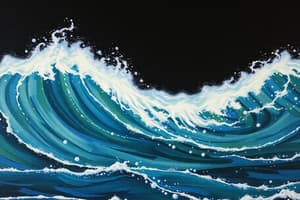Podcast
Questions and Answers
What characterizes the areas of compression in a wave?
What characterizes the areas of compression in a wave?
- Particles remain stationary and do not interact
- Particles are forced together and density increases (correct)
- Particles oscillate without changing position
- Particles are widely spaced apart
Which statement best describes rarefaction in a wave?
Which statement best describes rarefaction in a wave?
- It signifies a moment of no movement in the particles.
- It occurs only during the wave's amplitude peak.
- It is a phase where particles are expanded and spread apart. (correct)
- It involves a concentration of particles in a small area.
What do the small arrows in the diagram indicate?
What do the small arrows in the diagram indicate?
- The speed of the wave propagation
- The frequency of the wave oscillations
- The magnitude of wave amplitude
- The direction of particle movement during compression and rarefaction (correct)
In the context of sound waves, what is the significance of compression and rarefaction?
In the context of sound waves, what is the significance of compression and rarefaction?
Which label is appropriately associated with the areas where particles are pushed close together in the wave diagram?
Which label is appropriately associated with the areas where particles are pushed close together in the wave diagram?
Flashcards
Compression
Compression
Areas in a wave where particles are pushed close together, increasing density.
Rarefaction
Rarefaction
Areas in a wave where particles are spread apart, decreasing density.
Compression (in Sound Waves)
Compression (in Sound Waves)
The areas where particles are packed together in a sound wave.
Rarefaction (in Sound Waves)
Rarefaction (in Sound Waves)
Signup and view all the flashcards
Sound Wave Propagation
Sound Wave Propagation
Signup and view all the flashcards




